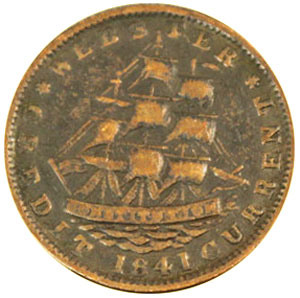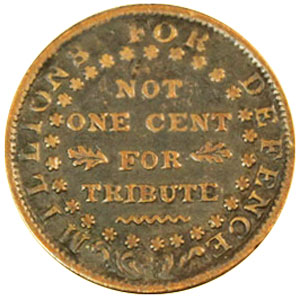Though we normally think of numismatics as the study of money – coins or paper, the term also includes the study of medals and tokens. Recently, a purchased collection contained an 1841 Webster Credit Current HT16 hard times token.
Let’s take a look. First, the obverse:
Now, the reverse:
Isn’t that an odd inscription, “Millions for Defence Not One Cent for Tribute?” Where does it come from?
The research into the quote’s background followed an interesting path.
In The Numismatist, Volume 27, page 299, the American Numismatic Association published a presentation about hard times tokens. On April 21, 1914, Dr. George P. French, presented an article on “Hard Times Tokens” to a meeting of the Rochester Numismatic Association.
He commented at the beginning of his presentation, “I was appointed by you at our last meeting to write an article on the Hard Times Tokens. I have had little time to devote to it, and I am sorry to say it will be somewhat abridged.”
Further in his presentation, he specifically mentions “Millions for Defence” and attributes the full quote to Charles Cotesworth Pinckney of South Carolina.
Who was Charles Cotesworth Pinckney?
In the Encyclopedia Americana, page 94, Charles Cotesworth Pinckney was born in South Carolina in February 1746 and died there in August 1825. He was educated in England, first at Oxford then at Middle Temple in London for law. Next, he studied military affairs at the Royal Academy in Caen, France after which he returned to Charleston to practice law.
He served in South Carolina’s first provincial congress in 1775 and in the Continental Army during the Revolution where he became a Brigadier General. In 1787, he was an active member of the United States Constitutional Convention in Philadelphia. And in 1790, Pinckney participated in the State Constitutional Convention of South Carolina.
In 1796, General Pinckney became the Plenipotentiary to France. Ordered by France to leave, he returned to the US. Upon his return, President Washington promoted Pinckney’s military rank to Major-General.
Back to the quote:
Before throwing Pinckney out of their country, the Directory of France attempted to extort money from the US for the French recognition of the new country. Supposedly, General Pinckney replied, “Millions for defence but not a cent for tribute.”
But, General Charles Pinckney of South Carolina did not utter those specific words. Digging further found an interview with the elderly statesman where General Pinckney explained what he really replied to the French and why he left the error uncorrected.
In The Chautauquan, Volume 30, page 349, the historians tell the story of the misquoted line which even found its way on General Pinckney’s memorial tablet after his death.
Side note for the following: the definition of gasconade is extravagant boasting or boastful talk.
General Pinckney’s response to the French extortion attempt was in reality, “Not a sixpence.”
But, long before telephones, televisions and the internet, people passed the quote, “Millions for Defence Not a Cent for Tribute,” among themselves through newspapers and hearsay.
Rather than try to correct the mis-attribution, General Pinckney felt he should just let the quotation be. He probably thought of Shakespeare’s “doth protest too much” in making that decision.
Since General Pinckney allowed the error to continue, Dr. French can be easily forgiven in his April 1914 presentation for the quote’s attribution to Charles Cotesworth Pinckney.
As for the Hard Times Token shown above, that one is listed as “HT16.” There is another version, HT17, with a similar obverse but the reverse has “For Tribute” in a semicircle above the lower portion of the wreath.
Depending on the condition of the Webster Credit Current Hard Times Tokens, their value on the market can range from a few dollars for the low end and over $100 for the high end of the grading scale.
The one above has some definition of its design, but you can barely read “CONSTITUTION” across the ship, and the ship’s sails are worn.
It would take a lesson in tokens and token grading, specifically for this token, to determine its true value – retail or wholesale.
But, the side trip into the token’s related history gives us interesting insights into the history of our founding fathers, in this case one who is not widely known, General Charles Cotesworth Pinckney.
Resources:
The Numismatist, Volume 27, June 1914, pages 296 through 300
The Encyclopedia Americana, 1919, pages 93-94
The Chautauquan: Volume 30, 1900, page 349
Publications of the Southern History Association, Volume 4, 1900, pages 65-66

